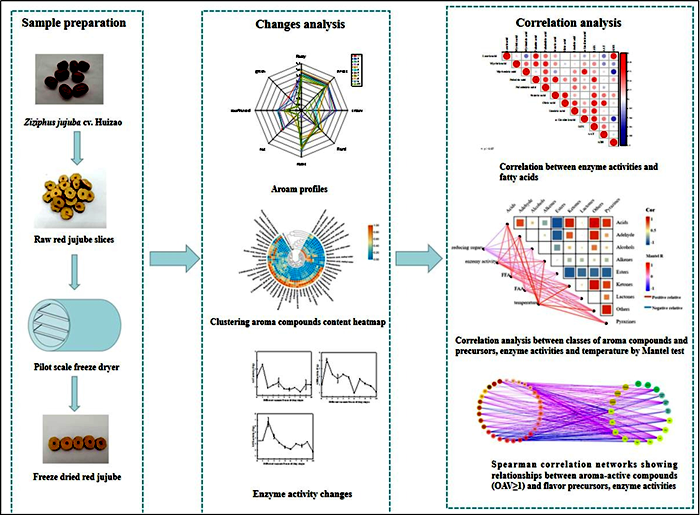Researchers from IFST-CAAS announced novel insight into the evolution of volatile compounds during dynamic freeze-drying of Ziziphus jujuba cv. Huizao based on GC–MS combined with multivariate data analysis
As food and medicine in China, red jujube ( Zizyphus jujuba Mill.) has high nutritional value and pleasant flavor. Its leisure products are also popular by consumers. Compared to the raw red jujube, The aroma of freeze-dried red jujube is quite different with the raw one. However, the causes of aroma differences between raw and freeze-dried jujube and the aroma formation pathway during freeze drying are still unclear. The development of aroma in freeze-dried red jujube is a dynamic and complex process that depends on the combined effects of drying condition, aroma precursors and enzyme activities.
The Fruit and Vegetable Processing and Nutrition Health Innovation group of Institute of Food Science and Technology (IFST), Chinese Academy of Agricultural Sciences (CAAS) investigated the dynamic changes in aroma compounds, precursors and related enzyme activities during the freeze drying of “Huizao”. The results showed that there were fifty-three volatile compounds identified in “Huizao” during freeze drying, and the total aroma contents were increased from 11,004 to 14,603 μg/kg after freeze drying. Through the network analysis, serine, glycine, proline, valine, cysteine, arginine, glutamic acid, lysine and leucine had the significant correlation with pyrazines, dominated the roasty note of freeze-dried “Huizao”. Linoleic acid, α-linolenic acid and oleic acid with lipoxygenase had important effects on the increase of esters (from 412 to 9,486 μg/ kg), contributed fruity and sweet notes of freeze-dried “Huizao”. Besides, through the Mantel test, the influence degree of factors on the formation of freeze-dried “Huizao” aroma was ranked as temperature > enzyme activity > fatty acids > amino acids. This study reveals the reason of changes in aroma content and profile, which can provide a theoretical basis for the flavor regulation of “Huizao” during processing.
The research was published online in the JCR Q1 journal Food Chemistry (IF="8.8)." Gou Min is the first author (Doctoral jointly trained by China and Belgium, 2019), and Professor Bi Jinfeng and Professor Chen Qinqin are the co-corresponding authors. This research was supported by the Financial Fund of Agricultural Science and Technology Innovation Program, Institute of Food Science and Technology, Chinese Academy of Agricultural Sciences (CAAS-ASTIP- 2022-IFST).

https://doi.org/10.1016/j.foodchem.2022.135368
-
 Apr 18, 2024Opening Ceremony of the Training Workshop on Wheat Head Scab Resistance Breeding and Pest Control in Africa Held in CAAS
Apr 18, 2024Opening Ceremony of the Training Workshop on Wheat Head Scab Resistance Breeding and Pest Control in Africa Held in CAAS -
 Apr 03, 2024IPPCAAS Co-organized the Training Workshop on Management and Application of Biopesticides in Nepal
Apr 03, 2024IPPCAAS Co-organized the Training Workshop on Management and Application of Biopesticides in Nepal -
 Mar 28, 2024Delegation from the School of Agriculture and Food Science of University College Dublin, Ireland Visit to IAS, CAAS
Mar 28, 2024Delegation from the School of Agriculture and Food Science of University College Dublin, Ireland Visit to IAS, CAAS -
 Mar 25, 2024Director of World Food Prize Foundation visited GSCAAS
Mar 25, 2024Director of World Food Prize Foundation visited GSCAAS -
 Mar 20, 2024Institute of Crop Sciences (ICS) and Syngenta Group Global Seeds Advance Collaborative Research in the Seed Industry
Mar 20, 2024Institute of Crop Sciences (ICS) and Syngenta Group Global Seeds Advance Collaborative Research in the Seed Industry
